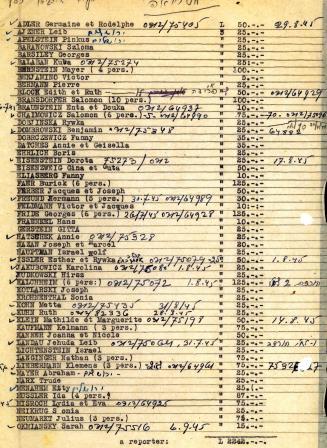Among Israel's fallen soldiers, there are about 650 soldiers about which very little is known. The organization "Latet Panim Lanoflim " (literally," To Give a Face to Those That Have Fallen") is a project that that is administered by the Ministry of Defense, and is active in finding as many details as possible about the anonymous, or virtually anonymous, fallen soldiers, in order to commemorate them in a dignified way. The project's volunteers work together with the Central Zionist Archives, the IDF Archive, and other relevant archives in Israel and abroad, in order to locate archival documents and piece together the life stories of the unknown fallen soldiers. One such soldier is Moshe Willinger.
Please See Rahel Wiesel
Moshe Wilinger's life ended on 15.8.1948. "The Last Member of his Family" – that was the simple writing on his headstone in plot number 5 on Mount Herzl, where the soldiers who died in the War of Independence in 1948 are buried. When the volunteers of "Latet Panim Lanoflim" opened his file in the Ministry of Defense, it was empty, save for one document on which was written "Please see Rahel Wiesel"'. From Willinger's burial documents at the Chevra Kadisha (the organization that oversees the preparation of Jewish people for burial) it learned that Rahel Wiesel was his cousin.
The next stop in the research led them to the Central Zionist Archives. Here, they found Willinger's card in the statistical catalogue of the Immigration Department of the Jewish Agency , and the mystery of his life started to unfold. His parents' names were listed on the card- Frieda and Baruch – as well as the places he stayed in before he came to land of Israel: the Auschwitz concentration camp , Birkenau, and Buchenwald.
The search in the CZA revealed another piece of the puzzle: in the past, there were two attempts to find Willinger, by a Holocaust survivor whose relationship to him was unclear: in 1945 and 1946. At the time of the second attempt, Willinger lived in a sanatorium for tuberculosis patients in Makor Haim in Jerusalem.
The documents found in the Archives led to more details. A German organization dedicated to finding survivors and victims of the Holocaust, found Willinger's prisoner cards in Auschwitz and Buchenwald. They listed his place of birth – Uzhgorod, Czechoslovakia - and the family's address. These details enabled the volunteers to find Willinger's uncle, who also made aliyah and settled in Tel Aviv. They contacted his son, Willinger's cousin, and he led them to two other cousins. And so, Willinger returned to his family, who had known nothing about him.
Here is Willinger's life story, which was pieced together by the archival research carried out by the organization:
 Look for me
Look for me
Moshe Willinger was born in Uzhgorod, Czechoslovakia in 1928. When he was a young boy, he was sent to Auschwitz, and towards the end of the War he was transferred to Buchenwald, where he worked in a coal mine. During his imprisonment there he became ill with tuberculosis. When the Americans liberated the camp he was 16 years old. The 244 children of the Buchenwald camp were sent by Youth Aliyah to France, and 150 of them, Moshe among them, were brought to Israel on the Mataroa – the first ship that bought Holocaust survivors to Israel after the end of the war.
The British transferred the passengers of the Mataroa in the Atlit detainee camp. Moshe stayed in the Atlit camps for three months, and after he was released, he came to Jerusalem and stayed in a sanatorium to be cured of tuberculosis. During this time a connection was made between him and his uncles, Ahaaron and Binyamin, who had also made aliyah.
After he was released from the sanatorium, Willinger studied electrical engineering, and, after the completion of his studies, he began working in an electric supplies store in Jerusalem. Rahel Wiesel, the women whose name was the first link in the organization's research, was a close friend of his at the time. He joined the Bnei Akivah youth movement, where his mischievous nature earned him the nickname "sich mir" – Look for me.
Willinger joined the Hagana in April 1948 and was assigned to the Etzioni Brigade that participated in the fighting in Jerusalem. He served in the 63rd battalion as a gunner, but, being an electric engineer, he was also sent to the front to repair Hagana communication lines in the field.
During the war, Willinger's Battalion was stationed in the north section of Jerusalem near the Mandelbaum house – the borderline between the Arab and Jewish neighborhoods of the city, near Sheikh Jarrah, an area that was one of the main battle fields in Jerusalem. The Arab legion made a number of attempts to take over the area. On the 15th of August another unsuccessful attempt was made. During the attack, the phone line that connected the Mendelbaum house to the Hagana headquarters was damaged. Willinger volunteered immediately to go out and fix it. He managed to complete his mission, but was shot on the way back, by a sniper. He died in the hospital at the age of 19 years old.